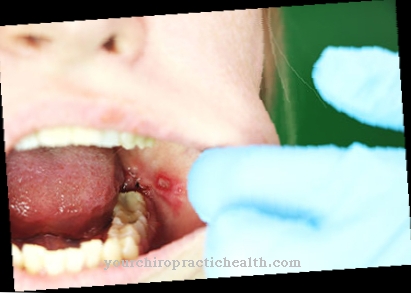Thyroid nodules often look worse than they really are and only in very few cases pose a threat to the person concerned. They are much more widespread in developing countries than in rich industrialized nations and also vary greatly in the way they arise.
What is a thyroid nodule?

© bilderzwerg - stock.adobe.com
A Thyroid nodules describes the morphological change in the thyroid, which is located in the throat and is responsible for important metabolic processes as well as for the storage of iodine and the production of vital hormones.
In medicine, we speak of so-called cold and hot nodes, which differ from one another through various characteristics.
A hot lump works independently and bypasses the thyroid gland and its so-called thyrotropic control circuit, which controls the release of hormones from the thyroid gland into the blood.
A cold thyroid nodule, on the other hand, refers to abnormal tissue that forms in the thyroid but does not produce hormones.
causes
In most cases indicates a Thyroid nodules a lack of iodine, which has to be taken in through food. Therefore, these also often occur in countries with a poor basic diet, in which a regular intake of iodine, which e.g. contained in eggs or fish cannot be guaranteed.
But also in some southern federal states of Germany there has been an iodine deficiency in parts of the population for many years. In the rarest of cases, the thyroid nodule turns out to be a cancerous ulcer that grows in the thyroid gland and is initially indistinguishable from a harmless, benign thyroid nodule.
Symptoms, ailments & signs
Thyroid nodules do not always cause symptoms at the beginning. If the organ is still fully functional, minor growths only cause slight swallowing difficulties and occasionally hoarseness. However, if the permanent pressure that the knot exerts on the thyroid gland becomes over- or under-functional, various health problems can arise.
Overactive people primarily experience diarrhea, weight problems and sweating. Affected people usually feel an intense discomfort, which occurs in episodes and subsides again in phases of rest. Underactive leads to tiredness, constipation and depressive moods. Thyroid nodules are usually not visible externally.
Only large growths can be felt from the outside. Occasionally they can be seen as a bump under the skin. The swollen lumps are painful when touched, which can immediately lead to cold sweat and dizziness. If the thyroid nodules are left untreated, other symptoms may develop.
Further growth inevitably leads to a disruption of the organ function, which in the long term also affects the hormonal processes in the body. Thyroid failure can lead to hair loss, chronic fatigue and altered skin texture. In addition, mental illnesses can occur, which are usually associated with other complaints.
Diagnosis & course
Thyroid nodules are usually noticed late or not at all by the person concerned, which is due to the fact that they often do not cause any pain or other discomfort.
Only above a certain size can they lead to swallowing and breathing difficulties, a feeling of pressure and the famous "lump in the throat" - by pressing on the nearby trachea and esophagus. Because of this, they are mostly discovered purely by chance during routine examinations and then examined for their respective properties and classification.
Cold lumps can only lead to more serious problems if they are overgrowth. Hot nodules, on the other hand, can degenerate into an overactive thyroid due to their autonomous release of hormones, which can manifest itself in diarrhea, palpitations, nervousness and weight loss. The consequence of a malignant thyroid nodule is metastasis, which, if left untreated, inevitably leads to death.
Complications
An untreated thyroid nodule can primarily cause hormonal problems. Hot lumps then lead to diarrhea, palpitations, nervousness or weight loss. Cold lumps often narrow the windpipe. This can lead to shortness of breath, shortness of breath and other breathing difficulties. If the thyroid nodule occurs in connection with polycystic thyroid disease, this can lead to the development of an underactive thyroid.
A lump on the thyroid gland can also cause difficulty swallowing. Depending on the size of the growth, there may be aspiration of food residues, which can cause shortness of breath and rarely lead to pneumonia. Another possible complication is chronic hoarseness, which mainly occurs when the thyroid nodule is left untreated for a long period of time. A malignant thyroid nodule spreads further metastases which, if left untreated, lead to death.
Surgical removal of a thyroid lump can result in bleeding, inflammation and occasionally damage to the thyroid. Radioiodine therapy can cause side effects such as loss of appetite, nausea, sore throat and temporary gastric mucosal irritation. Finally, there is a risk that the agents and materials used cause allergic reactions.
When should you go to the doctor?
A doctor must always be seen in the case of thyroid nodules. This disease cannot heal itself, so medical treatment is always necessary. The doctor should be consulted if the person concerned has difficulty swallowing. These usually occur without a particular reason and, above all, permanently.
Furthermore, a permanent hoarseness can strongly indicate the thyroid nodules and should also be examined if it occurs over a longer period of time without a particular reason. Furthermore, the thyroid nodules can also lead to diarrhea, constipation or very fatigue in the person concerned. These complaints also indicate the thyroid nodules and should always be examined. In some cases, severe dizziness or severe hair loss may also indicate the thyroid nodules and should be examined.
The first examination and consultation can be carried out by a general practitioner or a family doctor. A specialist is usually necessary for further examination or treatment. It cannot be universally predicted whether the life expectancy of the person affected is reduced by the thyroid nodules.
Treatment & Therapy
When treating Thyroid nodules basically two main procedures are used. On the one hand, surgical removal is recommended, especially if the lump has already reached such a size that it presses on the trachea and esophagus.
This is carried out in the event of a cancer finding without exception, whereby the experts still disagree on whether a complete removal of the thyroid is necessary or a selective removal of the affected tissue is sufficient. In the case of very large and already discomforting cold lumps, surgery is also usually advised to prevent damage to the sensitive esophagus and trachea.
The other variant of the fight, which only works with hot lumps, is the use of radioiodine therapy. The patient is given radioactive iodine, either in the form of syringes or capsules, which is deposited in the thyroid nodule and leads to decomposition and death of the newly formed tissue.
prevention
The best prevention against you Thyroid nodules is a balanced diet containing iodine that provides the thyroid gland with sufficient iodine to carry out its functions to a satisfactory extent. An additional intake of iodine in the form of tablets is a supplement worth considering, especially in children, to protect against thyroid nodules, but cannot replace a balanced diet.
A thyroid nodule is usually a relatively harmless phenomenon, but it can lead to more serious complications and complaints and should therefore be examined by a doctor - also with regard to a rare but possible cancer.
Aftercare
Diagnosing a thyroid nodule is not always a cause for concern. Inconspicuous thyroid nodules that are less than one centimeter in size often do not require annual follow-up care. A check-up every five years is sufficient for these nodes. In the case of more pronounced thyroid nodules, however, regular checks are advisable in order to differentiate between 'hot' and 'cold' nodules.
In addition, the size of the lumps is checked during the examinations and the formation of potentially dangerous cold lumps is counteracted. Surgery may be necessary if the lumps become too large. Alternatively, in mild cases, the specialist will prescribe medication to contain the enlargement. Another reason for follow-up care is the early detection of malignant changes in the cell tissue of the thyroid gland.
If the patient has pain or difficulty swallowing due to changes in the thyroid gland, a doctor is recommended. If necessary, a biopsy is done to examine the structure of the cell tissue more closely and to exclude or detect malignant changes at an early stage.
Such growths are rare in small nodes. For this reason, this kind of precaution only makes sense for conspicuous lumps larger than one centimeter. Even in this group of patients, the risk of cancer is very low with a rate of around 1.5 percent in women and 0.5 percent in men.
You can do that yourself
The thyroid nodule cannot be reduced by self-help in everyday life. Only surgery or possibly indicated radioiodine therapy can help here. If the thyroid nodule has proven to be benign with a high degree of probability after careful diagnosis, it can remain in the throat and be observed. In this context, self-help in everyday life also means taking part in this observation, but not constantly touching the knot. New swallowing or breathing difficulties, in addition to increasing size, are another reason to visit the doctor. Regular monitoring of the thyroid hormones in the patient's blood is also useful.
The lump is often associated with a feeling of tightness in the neck area. This may be more manageable if the patient does not wear tight scarves and scarves. Difficulty swallowing is also possible due to the mechanical obstacle of the knot in the throat area. Here it helps to take small bites of food, to chew it well and to ensure an adequate supply of fluids through drinking. Those who take thyroid hormones should definitely pay attention to their regularity.
A lump in the neck area is often a psychological problem for the patient. This can have aesthetic reasons with visible lumps, but also the fear of an undiscovered cancer. In many cases, surgery is the right decision.




.jpg)











.jpg)
.jpg)



.jpg)






